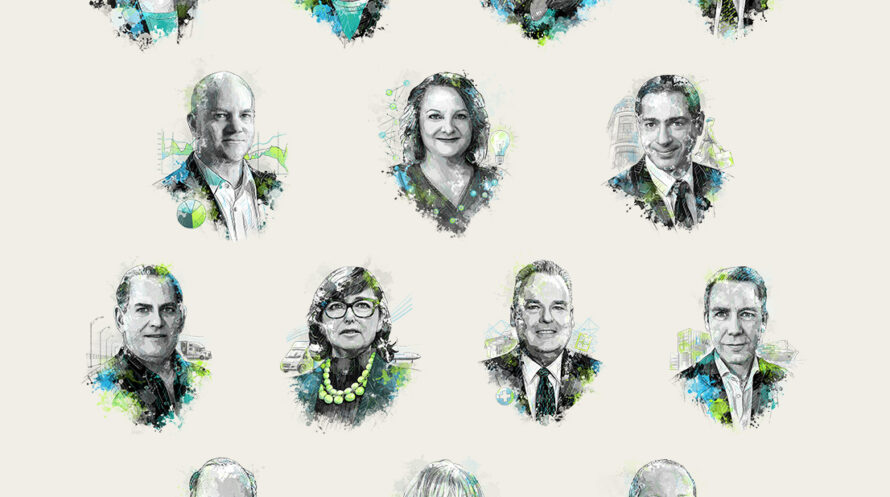Issue 2, June 2022
Can the business of property benefit the planet? Greg O’Brien thinks so
Progress in commercial real estate is often measured in years and decades, not days and months. But the pandemic had a way of turning incremental transformations into overnight pivots. Now an industry synonymous with incremental change is moving to address some of the most immediate and important trends facing our world.
Greg O’Brien, CEO of Markets at real estate services firm JLL, has spent three decades helping clients buy shopping malls, optimize their factory floors and acquire land for their next fulfillment space. Recently, however, clients are turning to him and his colleagues in real estate to help them solve pressing challenges born of a series of global crises: hybrid work, employee wellness and sustainability.
Driving sustainable building operations
With real estate responsible for nearly 40% of total carbon emissions, the sector has both an opportunity and responsibility to help the world discover new ways to reach emissions goals. Part of the solution includes major investments in renewable energy sources, such as hydropower, wind energy and solar. “As an industry that’s a part of the challenge, we’re excited to help make the built environment part of the answer,” O’Brien says.
Sustainability efforts are not only good for the environment, they’re also good for business. In 2020, JLL helped clients reduce their carbon dioxide emissions by 194 million pounds, driving $300 million in energy cost savings.
Everyone, regardless of where they work, wants to be in an environment that’s safe, comfortable and attractive.
The ability to tackle emission-reduction goals comes easier to some companies than others. New regulations and ever-shifting ESG requirements often leave clients with lofty ambitions—and no way to achieve them. To that end, JLL has invested in building out its in-house sustainability practice, helping clients both shape and execute their green efforts. “The reality is any company can be carbon zero tomorrow if they just shut everything down. But we know that’s not a reasonable ask,” O’Brien says. “What they have to do is go on a journey. We help them figure out where to start.”
Supporting healthier urban environments
COVID-19 supercharged the e-commerce landscape. Almost overnight, it overtook brick-and-mortar shopping for many consumers, spiking demand and straining the supply chain. In the first quarter of 2022, e-commerce represented 14.3% of retail sales, up from 11.9% prior to the pandemic and down slightly from the pandemic peak of 16.4%.
This rapid shift accelerated demand for industrial real estate, too, particularly in densely populated urban markets. Many companies have struggled to keep up with the spike. In the U.S., vacancies fell to 3.4% in the first quarter of 2022, marking the sixth consecutive quarterly decline. Overall leasing volume increased 17% relative to last year, led by logistics and distribution companies.
Increased consumer demand coupled with record-low vacancy rates has driven many companies to build upward. Multistory warehouses, commonplace in Asia, are becoming increasingly popular in the West. The first vertical warehouse in the U.S. opened its doors in Seattle in 2018, followed by plans for similar construction in New York and San Francisco.
“It’s a bit like renovating your house,” O’Brien says of the current situation facing space-constrained companies. “Maybe you need to shrink the dining room to expand the kitchen. If you need to stay in your house longer, then that’s what it’s going to take. This is the kind of calculus our clients are doing right now where they feel the supply constraints.” While market demand has so far propelled warehouses upward, the vertical trend also has important implications for sustainability. Vertical warehouses allow companies to place their fulfillment centers closer to population centers, reducing truck traffic and cutting back on carbon emissions, while reducing delivery times to consumers.
Making workplaces work better for people
Just as the commercial real estate industry can help improve outcomes for the planet, it can also make life better for employees. Over the past decade, an increasing number of forward-thinking companies have pursued WELL certification, optimizing their buildings to prioritize the health and safety of workforces. Focused on the attributes of buildings that affect human health the most, WELL measures how buildings optimize indoor air quality, how they leverage illumination levels to improve worker mood, and even how they support mental and physical health.
These efforts come at an important time. Driven by the existential concerns raised in the pandemic, an overwhelming percentage of the workforce has prioritized wellness, flexibility and even purpose when evaluating job opportunities. Thus, the built environment has become a critical component of attracting and retaining talent.
In addition, dynamic occupancy planning, powered by artificial intelligence, is giving companies valuable insights into how employees are using office space. Where are people sitting? Who do they sit with? Are fewer people using the office than we expect? The answers to these questions inform critical decisions about layout, construction and utilization.
“Something that still surprises me is that, despite the fact that labor is the No. 1 challenge for companies today, you still see many big firms that are trying to hire people into distribution centers supplied with just soda machines and aluminum chairs,” says O’Brien. “That just doesn’t work anymore. Everyone, regardless of where they work, wants to be in an environment that’s safe, comfortable and attractive.”
For O’Brien, these conversations reflect the shifting role of a centuries-old industry that has evolved from static spaces to dynamic environments. It’s also a sign of the times for brokerages like JLL, that were traditionally tasked with fulfilling fully baked business plans and are now integral partners in building those transformation roadmaps.



